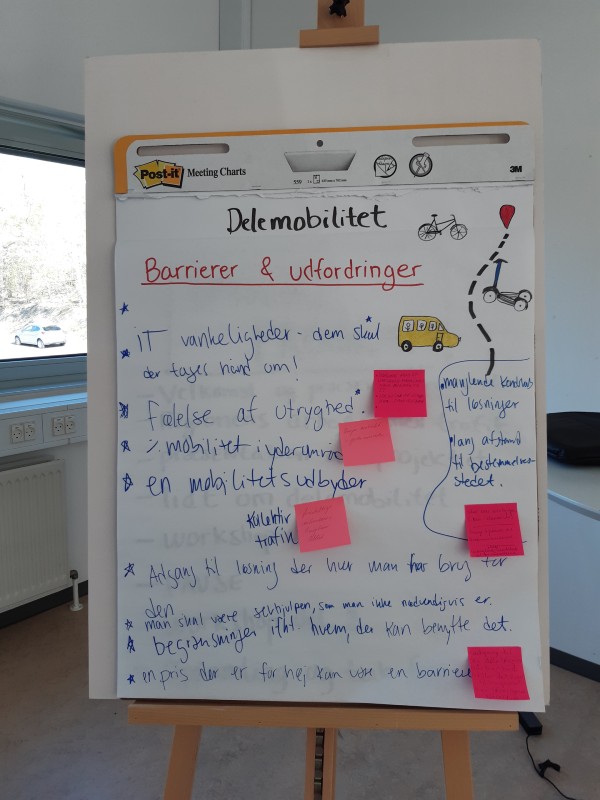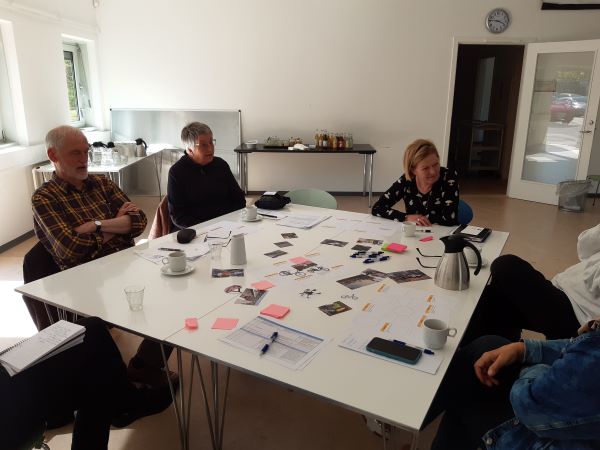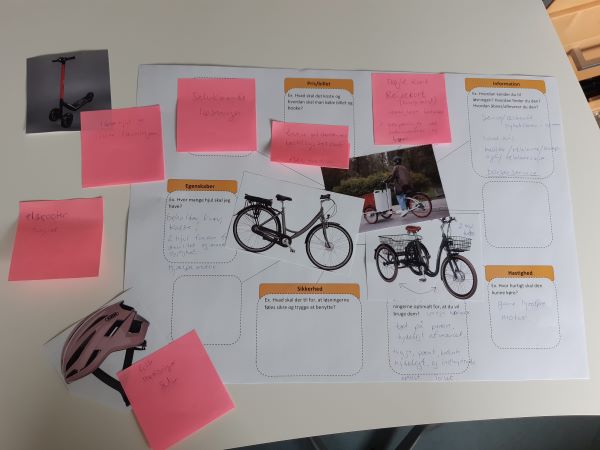How do you start meaningful conversations with the elderly about their mobility needs? To find out, we sat down with Kia Madsen, Project Manager for the Capital Region of Denmark for the Shared Mobility for All (SMALL) project. Kia has recently organised a first engagement event with participants from the local elderly council in the Capital Region to explore how shared mobility could be designed for their needs.
Kia, thank you for talking to us. Before diving into the topic, could you please first describe the role of the Capital Region of Denmark, and your mobility challenge that shared mobility can address?
The Capital Region of Denmark is one of five regions in Denmark. We have 29 municipalities and five different mobility operators. We in the region are responsible for the regional transport, regional bus lines and regional train and tram lines among other things.
In the region, we would like to increase accessibility and create better and more green mobility for people travelling both in the region but also to and from the region. One of our main challenges in the region - and I think this is one of the main challenges in most regions and in most countries - is of course car dependency.
Within the SMALL project, we are targeting some of our hospitals in the region. When we look at the data from the hospitals, we see that there is a large car dependency, both for patients, the employees, and the visitors going to and from our hospitals. This is especially true for the hospitals located outside the city centre.
One of the groups that use hospitals most frequently – and with the most specific mobility needs - is the elderly. How does an authority like the Capital Region of Denmark start planning shared mobility for elderly people?
When it comes to elderly people, we need to get a better understanding of their needs, their concerns but also their wishes and requirements when it comes to shared mobility.
It's a new target group that we need to plan for. It’s challenging because we need to use new approaches and involve new people and organizations. To my knowledge, we don't have any examples of any inclusive shared micro-mobility solutions in our region, so what we're doing with the SMALL project will be the first of its kind!
“None of the participants had ever tried any shared mobility solutions in their life, yet still came to the workshop.”

To get some first-hand insights on your work, you recently ran a workshop with participants from the elderly council of your Region. Tell us about this session and what you covered.
So far we’ve arranged two different engagement events, one meeting with a representative from an elderly organisation, and one workshop with participants from the elderly council of the Capital Region of Denmark.
In the workshop, we gave a presentation that introduced the group to shared mobility, its potential and its barriers for the Capital Region of Denmark. We explained how it works, and introduced the group to the operators we have in the region, to prepare them for later discussions. We used a lot of pictures and visuals for them to recognise shared mobility in the region.
The interesting thing was that none of the participants had ever tried any shared mobility solutions in their life, but they still came to the workshop. They were really listening and paying attention to our presentation; there was a real interest in it.
Overall, we talked about specific mobility solutions, technical features like the number of wheels, but also all the user journey including the booking, and the cost for a ride. We also gathered a lot of input which we can now take into a dialogue with private shared mobility operators.
Shared mobility solutions must be easy to book, to find and to pay, and have good stability: this is not the case now.
From this input, what did you learn about designing shared mobility for the elderly?
It was very clear that the current shared mobility solutions in the region do not cover what the elderly people need. The solutions must be easy to book, to find and to pay, and have good stability: this is not the case now.
In regards to hardware, we learnt that vehicles such as three-wheelers or cargo bikes with a basket were preferable, both electric and mechanical. When we discussed bike helmets, it became clear that it was not needed to include it in the sharing system (“if people need it, they will bring it from home”).
It was also interesting to discuss the surrounding infrastructure, and the need for toilets at the hub and stations area. This is very important for elderly people.
“Elderly people are less likely to use sharing systems if there is a lot of vandalism, because they do not want to be associated with such ‘experiences’”
What was the most surprising thing to come up in your discussions?
The most surprising discovery was the relation to vandalism. Elderly people are less likely to use sharing systems if there is a lot of vandalism, because they do not want to be associated with such “experiences”. The service needs to be “neat and have a high service level”. I was surprised that it was so important, and it’s really something worth thinking about.
Another thing was the ticketing and pricing. Shared mobility solutions should be part of public transport tickets, and you should be able to pay it with a hard card, a travel card. It makes sense as elderly people are familiar with public transport, and this should be the starting point for shared mobility for them.
How did you approach the organisation of this workshop? It can be easy to underestimate the organisation of events like this.
Yes, you are right, it requires more time and resources than what we usually think.
To begin with, we invited a lot of different organizations, but the reality was that not all these organizations had the time or the resources to participate.
Instead of losing their involvement, we invited the organizations who couldn’t attend to join a follower group. The follower group will be informed about the progress and results of the project, and received a summary following the first engagement events. We found that the organizations and stakeholders we invited thought it was an interesting and relevant project, but they couldn't prioritize it.
“We felt it was important to start with public transport - something they could relate to - and then move on to shared mobility”

Very interesting, it shows that you shouldn’t take for granted that organisations and end-users will automatically join your engagements events. And how did you ensure the elderly could relate to a topic they don't often engage with?
We had eight participants in the workshop. It was important for us to open with a discussion session about the experience of elderly people with public transport. We felt this was important because this is something they could relate to, and it helped them to get the conversation going to continue later with shared mobility, a concept they are less familiar with. After discussing the challenges and the potentials, we moved on to discuss all the things we should keep in mind when designing shared mobility solutions such as digitalisation and adapted vehicles.
Starting with a familiar concept (public transport) to lead to shared mobility, that’s a great idea to engage in the conversation! What did you learn about organising such an event? What would you change or improve if you had to do it again?
In future, we want to extend beyond public transport users to engage with people that are very much dependent on their car and those who are not willing to travel in another way than by car.
Another learning during the workshop: we found out that our focus on hospitals was limiting the discussions. When thinking about hospitals as an older person, you are not thinking about the trip itself, but the destination. You are more concerned about your health issue than the way you get to the hospital.
So, we tried to open the conversation and not to focus too much on the hospitals because when we did, the response was understandably “When I’m really sick, I need a taxi”.
Interesting to see the trade-offs you make when focussing on a specific use case. Summing up, what are you going to do with this knowledge and what are the next steps in your planning process?
First of all, we invited all the participants to take part in the upcoming testing and evaluation phases of the pilot. The insights from the discussions will create the foundation for our dialogue with the private shared mobility providers in the region to explore how we can adapt solutions to the needs of elderly.
“The idea would be to erase inclusivity from our vocabulary and that it just becomes the new normal”

Great! We will be very curious to hear about your conversation with shared mobility operators as they are a strategic partner to convince and engage with obviously. Perhaps this will be the topic of our next chat. Final question: as we still have three years to go in the project, what is your ideal vision with Shared Mobility for ALL? What would you like to have achieved by the end of the project?
I would like us to be able to create inclusive solutions as a standard when planning mobility for people, and not have to make the active decision to do so. The idea would be to erase inclusivity from our vocabulary as it just becomes the new normal.
Outgrowing the need for the word inclusivity, I love that. What a great way to finish this interview. Thank you very much Kia, and we look forward to chatting with you again soon.
The SMALL project aims to co-create and test new shared mobility solutions for children and families, elderly people and physically impaired users. Follow us on our journey to truly inclusive shared mobility on LinkedIn – and if you want to be a champion of shared mobility for all in your area, get in contact with us!
Shared Mobility for ALL is co-funded by the Interreg North Sea programme.
